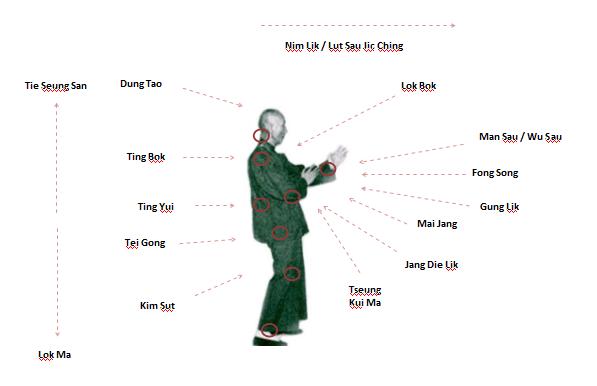Understanding Structure
Sil Lim Tao Stance
YEE GEE KIM YEUNG MA
Lik Chong Gerk Jang Sang
Whole body structural alignment
| 1. Ankles | 5. Shoulders |
| 2. Knees | 6. Neck |
| 3. Hips | 7. Elbow |
| 4. Spine | 8. Wrist |
Cantonese Translation:
Kim Sut – Knees In. Creating the lower triangle with legs.
Lok Bok – Dropping shoulder. Isolated, relaxed shoulder.
Lok Ma – Lowering Horse. Sinking / rooting the stance.
Jang Die Lik – Elbow under strength. Stabilising and sinking the elbow.
Fong Song – Relaxed extending arm.
Ting Yui – To straighten the back. Flattening the lumber area of the spine by stacking the vertebrae’s.
Dung Tao – Upwards lifting head. The straightening of the neck and head at the top end of the spine.
Tei Gong – To make solid. The lifting of the anus muscle and tilting of the pelvis to engage the hips – uniting lower triangle (legs) with upper triangle (body).
Tie Seung San – Uplifting upper Body – the sensation of the upper body being held up by string resulting from Dung Tao, Ting Yiu and Tei Gong.
Ting Bok – Straight back shoulders. The back held back isolating the shoulders and forming the upper triangular structure.
Nim Lik – Force of idea / Intent. Mental focus in the application of structure.
San Ying – Body Structure.
Lut Sau Jic Ching – Forward springing force.
Gung Lik – Trained Strength. Maintaining the correct arm position / angle.
Tseung Kui Ma – Elbow position maintained (fist distance from body)
Mai Jang – Forwarding of elbows inward and forward.
Man Sau / Wu Sau – Correct hand positing using relaxed use of tendons / ligaments to give structure to arm.
Lik Chong Gerk Jang Sang – Power originates from the heals – meaning structural power through the alignment of the 6 major joints.
Copyright @ Craig Sands
A detailed overview explaining each of these elements within the Wing Chun Yee Gee Kim Yeung Ma stance is provided within the article "Relaxation versus Structure Dilemma - Article 2" here: Link

You must be logged in to post a comment.